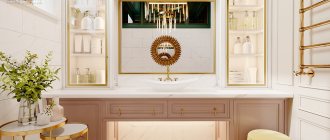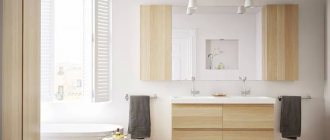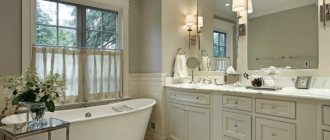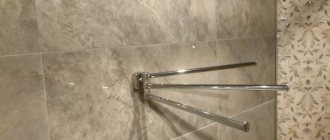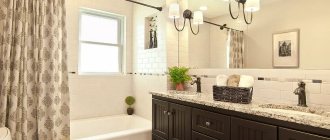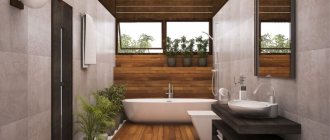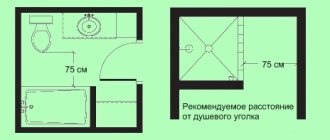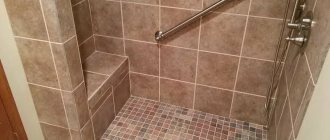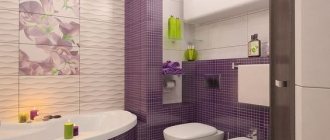Porcelain tiles, concrete, paint, wallpaper, and maybe steel and wood! Immortal ceramic tiles have many competitors for bathroom wall decoration. The choice of materials for repairs today is huge. It all depends on personal design preferences, the style of the room and the size of your personal budget. Read the information in this article, which will allow you to learn about the types of bathroom wall decoration, taking into account all the nuances.
Walls in the bathroom: features of the choice of finishing material
The bathroom is a place that is used not only for hygiene procedures, but also to improve mood and well-being after a grueling day at work. Here people relax, refresh themselves and forget about their problems for a moment. Pleasant and aesthetic decor is preferred. The appearance of the floors and walls determines the overall design of the bathroom. Today there is a wide selection of finishing materials for premises of this type. The times when only ceramics were applied to walls are already in the past. While tile is still popular and trendy, other finishes have come into play:
- stone cladding;
- wallpaper;
- structural plaster;
- glass;
- tree.
The most important thing is that the material selected for the walls in the bathroom is practical and resistant to moisture, and that you like the end result. For traditionalists who can't part with their tiles, there's good news. Modern ceramics are not similar to those that existed several decades ago. Innovative tiles imitate other materials, such as lining or stone. It has new, bold patterns and shapes, from straight to highly curved, with jagged edges, providing interesting compositions.
Bathtub with wallpapered wall
Wallpaper is a good alternative to tiles. They perfectly mask uneven walls, are easy to apply and relatively inexpensive. For bathrooms, vinyl or fiberglass wallpaper coated with acrylic varnish or epoxy paint is used. Since the bathroom has high humidity for wallpapering, you should only choose waterproof adhesive. The wallpaper fits and matches perfectly with ceramic tiles. The vinyl version has a layered structure: paper on the inside and vinyl on the outside. This coating is resistant to light, so the wallpaper retains its color and water resistance.
Fiberglass wallpaper
Fiberglass wallpaper is very resistant to mechanical damage. They can successfully stay on walls for several decades; they are difficult to remove from the wall. The fiberglass merges with the surface. This wallpaper is designed to be painted.
What do you need to remember when decorating a bathroom with wallpaper?
All wallpaper patterns can be varied using borders that have different widths of colored or patterned stripes. The border also serves as finishing. Although wallpapering is simple and does not require complicated tools, there are some important things to remember to avoid peeling:
- If you decide to use wallpaper, you must remember to choose the right adhesive and base primer. There are many quality glues available in the market today. Each wallpaper manufacturer can offer a specific product that is best suited for wallpapering. These materials must have vapor and waterproof properties.
- Be aware of the moisture resistance of wallpaper and the dangers associated with it. It is advisable to apply wallpaper in a room that has effective rotary or mechanical ventilation so that the material is not exposed to prolonged contact with water. Experts don't recommend wallpaper for small bathrooms because it can release too much moisture from the wall.
Bathtub wall paint
Paints intended for wet rooms have special formulas in their composition that protect the painted surface from moisture penetration and the development of various types of mold and fungi. Most often these are silver ions. They are available in a very wide range of colors, so you can perfectly match the color to your interior or furniture. Suitable properties, low price and ease of application to the wall make the paint a unique solution.
Paint the bathroom instead of tile? A smart decision, since bathroom paint protects the walls of the room from moisture and provides long-lasting colors. A bathroom without tiles is an increasingly popular solution. You can decorate surfaces with stickers, wall murals or even panels.
Tips and tricks
Current bathroom trends recommend minimal use of tiles, that is, only in the wet area. Is a bathroom without tiles practical? How to decorate the walls in the bathroom? You can paint the room, but be sure to choose special substances that are resistant to moisture. It’s worth making this decision when we don’t have a shower, when you want to create a special room design, for example, a Provençal, romantic bathroom in a rustic style, or you simply don’t want to invest heavily in plumbing.
How to protect bathroom walls from moisture when painting?
To paint the bathroom, use special paints that do not let moisture in and allow the wall to breathe. If the room is large, move the bathtub away from the wall as this will protect the plaster from splashing. If the plumbing fixtures must be next to a wall, you can use a large format wall mural or attach a mirror surface to the tile. This decoration of bathroom walls gives the interior style and a pleasant warmth that is always liked. A bathroom without tiles will have an interesting and cozy character, and the color of the walls in the room will undoubtedly be easier to change next season than investing in new tiles.
Stylistic directions
The style of the bathroom can be anything, but most homeowners adhere to certain ready-made solutions for bathroom design. Most often, the toilet is decorated in a classic style. This option looks beautiful and elegant. It is especially suitable for large bathrooms with a window. And the Art Nouveau style will be appropriate in small bathrooms. It allows you to install small functional shower cabins in the toilet. Art Nouveau is characterized by a natural palette of colors, floral motifs and the presence of all kinds of accessories with floral patterns. Among modern stylistic trends, it is worth highlighting bionics. This design style is characterized by the imitation of everything natural. Many people decorate their bathrooms in marine, ethnic, Scandinavian or Mediterranean styles. They look impressive and allow you to bring non-standard design ideas to life.
These styles can be combined.
Practical bathroom - floor, walls in stone finish
Stone is an extremely durable and water-resistant material. Damage caused during use is very little visible and can be easily repaired. It also adds elegance and class to even a small sized bathroom. In principle, any stone can be used in a hygiene room, provided that it is properly prepared, that is, polished and impregnated. When it comes to natural stone used at home in the bathroom, the most popular are:
- granite is practically the most durable and does not require impregnation;
- travertine is very porous, which makes it quite susceptible to moisture; Avoid using it in places with high humidity; it is suitable for bathroom floor;
- marble - a wide choice of colors and structures, suitable for almost any interior, very effective on large surfaces, but loses its charm in a small bathroom;
- onyx is unusual, irregular in colors, fits perfectly into the mosaic on the wall of a small bathroom.
Decorating the walls in the bathroom with decorative concrete
Concrete is increasingly being used in modern bathrooms. Due to its strength, it is used as a finishing material for floors. The material is perfectly smooth. It goes well with spaces that embrace both minimalist aesthetics and glamorous interiors with rich, shiny accessories. In the bathroom, concrete can be used in areas such as vanity tops, bathtubs, or shower trays.
The recommended solution is the use of architectural concrete slabs, which are characterized by high mechanical strength and water resistance. The arrangement of the bathroom, thanks to the use of this material, will acquire a unique charm.
Requirements for finishing materials for the bathroom
It is better to choose finishing materials for the bathroom and the entire apartment that will be easy to install. This is true even if the premises are renovated by hired workers. If the tiles or panels in the bathroom are damaged, it will be better if the homeowner himself can fix them without resorting to expensive repairs. Materials used for the bathroom must be moisture-resistant and antiseptic. The air in the bathroom is saturated with a huge amount of water vapor, which can gradually destroy the finish. Fungus can easily form in bathrooms due to dampness and poor ventilation. To avoid this, you should buy special antiseptic materials. When taking a hot shower or bath, the energy of the water is automatically transferred to the air, causing it to become very hot and have a destructive effect on the lining. Also, the materials should be different:
- ease of maintenance and operation;
- environmental friendliness;
- chemical resistance;
- high strength, etc.
Bathroom wall tiles are still fashionable
True, the choice of materials for walls is very large, but clients do not forget about tiles. It is fashionable, the structure resembles panels of metal, steel and precious stones. Manufacturers presented design lines such as wood, fiori, gold, silver, steel and green stone. Tiles can come in different sizes and shapes. In addition, decorative elements, inserts and inlays can be introduced. Ragged edge tiles are still in fashion, matching antique-Mediterranean and rustic styles.
Bathtubs with a glass wall
Glass comes in different thicknesses, transparency, patterns and colors. First of all, the bathroom uses safety tempered glass, laminated or reinforced. The impact breaks such material into pieces with unfocused edges, splashes or only a network of cracks in the sheet. Luxpheres and blocks are popular. They have different sizes and shapes: square, triangular, round. Glass cladding is placed on the wall, which can be made in the form of large panels or tiles with standard ceramic elements, that is, squares and rectangles of different sizes and mosaics.
Differences between flexible stone
This modern material is presented in three layers:
- Fabric base.
- The adhesive itself.
- Rock in the form of fine chips (marble, quartz, granite).
From a distance they can be mistaken for natural stones. This material is very durable, practical, and can withstand even very damp rooms.
Ideas for a fashionable interior
The design of the bathroom can be individualized not only in terms of equipment, but also in terms of decor. The bathroom is a place in the home where you can experiment with design. Consider rooms large and small that don't have traditional tiles on the walls. Instead, graphics, photographs, paintings, bricks, wallpaper and rubber cladding appeared.
Collage of photos on the wall
A collage of photographs on the bathroom wall is a very strong accent. This required tinted fixtures, hence light tiles for the bathroom, the same on the floor, walls and white sanitary ware. The impression of more space in the bathroom is given by the diffused light from many halogen lamps. The illusion is supported by a wall-hung sink; the fewer elements touch the floor, the easier it is to create the impression of space in a small bathroom. It was decided to unify the colors of the paintings decorating the walls of the bathroom, because their entire range in many photographs would bring visual chaos to a small interior. The choice fell on sepia combined with a small amount of bright colors. This is how photo wallpapers for the bathroom were created, which are protected from moisture by a glass sheet sealed with silicone. This is a much more interesting and practical solution than tiles, but it only requires a carefully leveled wall.
Wall painting
Painting in a bathroom where there is a lot of steam? Why not? However, it must be protected from moisture using laminated or glued glass; treatment with a special substance is possible. Floral motifs add depth to the bathroom interior. These effects are also enhanced by retro-style accessories. Great idea to liven up your bathroom.
Combination of different finishing materials
A trendy idea for a bathroom wall is to combine ceramic or stone tiles with wood, brick or glass. Such a wall in the bathroom makes the arrangement more interesting and the room more extraordinary. Avoid choosing tiles that have patterns because the wall coverings will compete with each other. You can also cover your bathroom walls with bricks. It's very decorative, but don't go overboard with the surface area. Then choose the simplest hardware and accessories in muted colors. If you like a sparsely decorated bathroom, paint the walls with paint that is resistant to moisture and fungi. Wet areas around the washbasin, toilet and bathtub can be tiled to add coziness, for example in warm colours.
A good idea for bathroom walls is stone or concrete. Fashionable stone tiles come in large formats and are usually laid without any joints. The second trend in bathroom walls is slate tiles with a brick-shaped texture. In this case, stick them to only one wall in the bathroom, for example, so as not to overload the interior. Concrete doesn't have to be real, but substitutes are just as good. You will get a great impression of a concrete bathroom wall by using structural paints. The varnished material will provide sufficient protection against moisture on the walls of the bathroom, being an excellent decoration.
What can you save on?
Before you start renovating your bathroom, you should consider the items on which you can save money:
- Refuse the services of a designer and draw up the project yourself;
- Do not hire craftsmen, doing some of the work yourself;
- Choose finishing from inexpensive materials;
- Bring funds for repairs on your own, without paying for transportation services;
- Buy a bath not made of cast iron, but made of acrylic or steel;
- Do not spend money on a “smart” toilet, but limit yourself to a regular one.
If you are on a limited budget, you should not choose an elaborate style of room decoration. Minimalism will be enough. No decorations or unnecessary details - everything is only necessary and functional.
You can also pay attention to art deco, hi-tech, modern. In this case, you can limit yourself to glossy textures, mirrors without expensive frames, modern lighting, use plastic and plain tiles.
Laying wall tiles in the bathtub with your own hands
Tiles on the wall in the hygiene room work well in all places that will come into contact with water: above the bathtub, in the shower, behind the sink. You just need to mount them there. Tiles on a bathroom wall do not have to cover the entire surface; sometimes it is enough that they are installed only in areas prone to splashing and sinking. Well-laid tiles will protect the wall, being a decorative element.
Bathtub wall renovation: important decisions
Choosing the type of tiles for the bathroom and installation methods should not be left until the last moment. The final layout at the construction stage allows you to choose the best materials and avoid unnecessary problems when finishing the bathroom. Working with tiles is a tedious and time-consuming task. Installation requires care and careful preparation. It is not enough to vacuum the substrate and simply stick the tiles. The need to arrange patterns, cutting elements and finishing all elements forces you to plan the finishing of the floor or walls in the bathroom, so choose the appropriate type, size, pattern, measure simple surfaces and cutting places, determine the finishing method.
Laying tiles should always start from the most exposed area. If this is a corner of the room, then the surface should be finished as much or evenly as possible, and the joints should be carefully processed. If the attention is not focused in a specific place, but only on a larger surface, then you need to take care of a harmonious appearance or deliberately insert a strong decorative accent that will attract attention. Regardless of the solution used, the cladding should look beautiful. To cut and grind the elements, you must use the appropriate tools, and the holes for sockets or pipe passages must be made with a hole saw of the appropriate size thanks to a hammer drill.
How to lay tiles on a bathroom wall?
The bathroom is constantly exposed to direct water, steam and high concentrations of moisture, meaning that microorganisms can easily grow here. They always choose the most absorbent surfaces where moisture remains for a long time, including corners. For this reason, bathrooms should be finished with materials with reduced absorption capacity, as well as those that have properties that limit the development of mold and fungal spores. The material must also be impervious to microorganisms. It is important to properly protect the surface from water, for example, with a foil backing. The seal can cover all surfaces, but is not required. However, the seal should always be on the floor, extending 15cm up the wall. In the bathtub and shower area, the tiles must reach at least 20 cm above the water coverage area.
Laying tiles in a shower stall
A typical shower stall is 200 cm high. The tiles on the wall there should be placed up to its top edge. But if there is a bathtub or washbasin nearby, although this is not necessary, the tiles in these places can also be laid to a height of up to 2 m. In the latter case, the internal architecture will be consistent.
Tiles in the bathroom on the floor of the wall or laying up to the height of the sink
If the bathroom doesn't have a stall or the shower is behind a wall, the tile height can be determined by the sink. Such tiles will be a kind of high panels, reaching almost 120 cm. If the color of the material and the walls above it is contrasting, it is worth knowing that a horizontal division of the surface, falling just below half the height, will visually raise the interior, and a little higher will lower it.
The starting point for determining the height of tiling in a bathroom can also be the height of a door or other architectural element, as well as niche windows. Whenever possible, tiles are placed at the height of the center element.
Plastic panels
PVC wall panels are another inexpensive alternative to bathroom tiles. Their beauty is that the walls don’t have to be level: they are attached to the sheathing, which will hide all the unevenness. The second advantage is that they are inexpensive and can be installed quickly. Another plus is a large number of colors, including plastic panels that imitate laid ceramic tiles, mosaics, and decorative panels.
Plastic for bathroom walls - there are different options
Another positive point: under plastic wall panels you can easily hide all communications, and they are also easy to clean. But to prevent mold from growing under the finishing, the walls must be primed with an antiseptic compound and good ventilation must be ensured.
The disadvantages of this method of finishing a bathroom are that the lathing takes up quite a significant amount of space, which is important. And the second disadvantage is that the panels are fragile and with significant force the jumpers are pressed into them. If you hit it with your elbow, you won’t be able to pierce through normal-quality slats, but there will definitely be a dent, and this spoils the appearance.
The installation of plastic panels is described in detail here.
How to paint the walls in the bathroom?
Painting bathroom walls is much easier than laying tiles, but you can make mistakes here. Find out the basic rules that everyone must follow in order for the room to be properly decorated.
The bathroom, like the kitchen, toilet, and laundry room, are rooms called wet because here the surfaces can constantly come into contact with water. Therefore, parts of the walls in the sink, bathtub and shower stall, that is, exposed to constant contact with humidity, must be covered with tiles. The rest of the bathroom can be painted. Unfortunately, too much moisture absorption through walls carries a certain risk, especially in damp areas, as excess steam condenses on the walls. Additionally, if the room is warm, mold and mildew may grow. This is why it is so important to prepare the walls well and apply the appropriate paint.
How to prepare the walls?
- First, you need to thoroughly clean the substrate from any dirt, dust and grease, for example, with water and detergent. In the case of a moldy surface, you must remove old layers of paint, wash the wall with water with an antifungal agent added and brush it.
- Secondly, when the wall is dry, you must level it. Damage to the plaster is completed with a gypsum finish or filler, which is then smoothed with fine-grained abrasive paper. Then, using a brush or damp cloth, remove all dust, most of which collects in the corners.
- Thirdly, the wall must be primed. Don't skip this step as painting may result in stains, discoloration, and uneven finishes.
Paint selection
First, you need to decide what paint you will paint the bathroom with, and then buy a ready-to-use primer recommended by the same manufacturer. After priming, the wall should dry well. For wet rooms, paints or special paints and varnishes that are resistant to moisture are recommended. The packaging must indicate that the product is intended for bathrooms. The paint must be resistant to washing and cleaning with detergents, and also protected from bacteria or mold.
